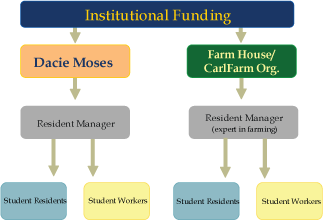
Farmelton
The Carleton Farm
A project of the Bio 160 Agroecology Course
Managing the Farm
|
|
|
Sources of funding from within Carleton |
Model for Carleton Farm: Dacie Moses House
Manager: Julia Uleberg Swanson
Residents/Student workers: Has two house residents and a couple student workers
Department: Under the Dean of Students. What department will are farm be under? Biology? Geology? ENTS?
She says that starting small is good because you can always build up. With our farm, it doesn't have to start off big, but can start small. She suggest talking to Mike Kotchevar-head of student workers and Nancy the Arb director. Michael Kotchevar, Assistant Director of Student Financial Services, agreed that Dacie Moses House would provide a good model for our farm. He stressed the importance of having a supervisor who could organize student workers and serve as an advocate on our behalf. There are several steps we would need to take as a group if we wanted to use student workers on the farm, assuming that we would not have a complete proposal until next fall. In October, Fred Rogers sends notes to all the department heads asking them how much money they need for the following year, which includes things like office supplies and salaries for the staff. The departments calculate how many student workers they believe they will need and how many hours a week each one will work. So, after we have a supervisor, we would need to calculate how many workers we would need and total the amount of money they would make for the year. In February, the board of trustees has to approve the budget, which includes all the money needed for student workers. |
|
Contact alums in agro-related fields |
|
|
How Geology ENTS & Biology will benefit |
|
A Carleton Farm in the Northfield Community A symbiotic relationship... |
|
|
The role for staff and student workers |
|
